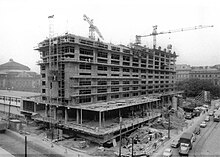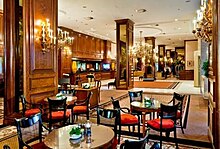
The Chicago School refers to two architectural styles derived from the architecture of Chicago. In the history of architecture, the first Chicago School was a school of architects active in Chicago in the late 19th, and at the turn of the 20th century. They were among the first to promote the new technologies of steel-frame construction in commercial buildings, and developed a spatial aesthetic which co-evolved with, and then came to influence, parallel developments in European Modernism. Much of its early work is also known as Commercial Style.

The Shanghai World Financial Center is a supertall skyscraper located in the Pudong district of Shanghai. It was designed by Kohn Pedersen Fox and developed by the Mori Building Company, with Leslie E. Robertson Associates as its structural engineer and China State Construction Engineering Corp and Shanghai Construction (Group) General Co. as its main contractor. It is a mixed-use skyscraper, consisting of offices, hotels, conference rooms, observation decks, and ground-floor shopping malls. Park Hyatt Shanghai is the tower's hotel component, comprising 174 rooms and suites occupying the 79th to the 93rd floors, which at the time of completion was the highest hotel in the world. It is now the third-highest hotel in the world after the Ritz-Carlton, Hong Kong, which occupies floors 102 to 118 of the International Commerce Centre.
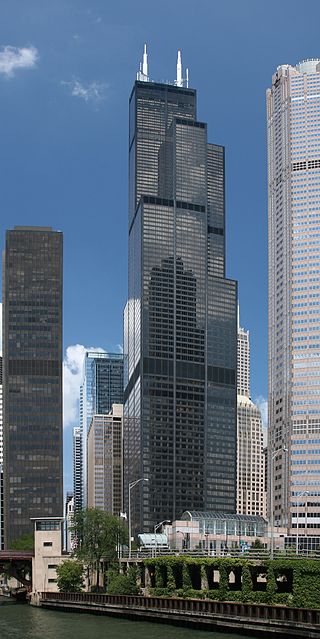
The buildings and architecture of Chicago reflect the city's history and multicultural heritage, featuring prominent buildings in a variety of styles. Most structures downtown were destroyed by the Great Chicago Fire in 1871.
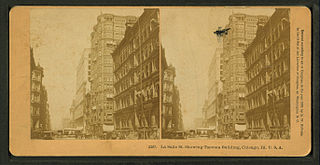
The architectural firm now known as Holabird & Root was founded in Chicago in 1880. Over the years, the firm has changed its name several times and adapted to the architectural style then current — from Chicago School to Art Deco to Modern Architecture to Sustainable Architecture.

The Millennium Tower is a 50-storey, 171 meter skyscraper, the second tallest building and fourth tallest structure in Austria at 171 metres. The tower is located at Handelskai 94–96 in the Brigittenau 20th district in Vienna, Austria. An antenna mounted on top of the tower brings the total height to 202 metres but does not count towards the building's architectural height.

InterContinental Warsaw is a five-star hotel in Warsaw, located between Emilia Plater, Śliska, and Sosnowa Streets.

The InterContinental San Francisco is a high-rise hotel at 888 Howard Street in the South of Market district of San Francisco, California. The 103.63 m (340 ft) 32-story hotel has 550 hotel rooms, and is operated by the InterContinental Hotels Group. The hotel is next to the Moscone West Center, completed in 2003. The hotel opened on February 28, 2008. There is a two-level underground garage and a six-floor podium housing hotel amenities.

The LaSalle–Wacker Building, at 221 North LaSalle Street, is a 41-story skyscraper at the north end of the LaSalle Street canyon in the Loop community area of Chicago, Illinois, United States.

George A. Fuller was an American architect often credited as being the "inventor" of modern skyscrapers and the modern contracting system.
The Residences at Greenbelt – Manila Tower is a residential condominium skyscraper in Makati, Philippines. It is the third of three buildings constructed as part of The Residences at Greenbelt (TRAG) complex, and has a similar dimension to The Residences at Greenbelt - Laguna Tower. It is one of the tallest skyscrapers in the Philippines with a height of 170.75 meters (560.2 ft) from the ground to its architectural top.
The Residences at Greenbelt – Laguna Tower is a residential condominium skyscraper in Makati, Philippines. It is the first of three buildings being constructed as part of The Residences at Greenbelt (TRAG) complex, and is the basis of the now being constructed The Residences at Greenbelt - Manila Tower. It is expected to be one of the tallest skyscraper in the Philippines with a height of 170.75 metres from the ground to its architectural top.

The Lafayette Building, also known as Export-Import Bank Building, is a federal government office building at 811 Vermont Avenue NW in Washington, D.C. Completed in 1940, it was declared a National Historic Landmark in 2005. Its landmark designation was made because it was home to the Reconstruction Finance Corporation, the government arm that financed and oversaw the mobilization of the United States economy during World War II. It is currently home to the Export–Import Bank of the United States and to offices of the United States Department of Veterans Affairs.

The Intercontinental Tower, Manchester is a cancelled landmark skyscraper that was proposed in Manchester city centre, England. The building would have been a five-star luxury hotel run by InterContinental Hotels Group, and developed by Northern Irish development firm, Benmore.

The Hotel St. Moritz was a luxury hotel located at 50 Central Park South, on the east side of Sixth Avenue, in Midtown Manhattan, New York City. The structure was extensively rebuilt from 1999 to 2002, and today it is a hotel/condominium combination known as The Ritz-Carlton New York, Central Park.

Wilshire Grand Center is a 1,100-foot (335.3 m) skyscraper in the financial district of downtown Los Angeles, California, occupying the entire city block between Wilshire Boulevard and 7th, Figueroa, and Francisco streets. Completed in 2017, it is the tallest building west of Chicago. Though the structural top of the Wilshire Grand surpasses L.A.'s U.S. Bank Tower by 82 ft (25 m), the roof of the U.S. Bank Tower is still 90 ft above the Wilshire Grand's. The Skyscraper Center lists the Wilshire Grand Center as the 15th-tallest building in the U.S. and the 95th-tallest in the world. It won the Structural Engineering Award 2019 Award of Excellence from the Council on Tall Buildings and Urban Habitat.

The Tacoma Building was an early skyscraper in Chicago. Completed in 1889, it was the first major building designed by the architectural firm Holabird & Roche. The Tacoma Building was demolished in 1929 to be replaced by One North LaSalle.
The Intercontinental Shanghai Wonderland, also known as the Tianma Pit Hotel, Shimao Quarry Hotel, Songjiang, or Pit Pegasus Hotel is a unique hotel in Songjiang, Shanghai, China, 50 kilometres from city center. The hotel, which started operations on 20 November 2018, is managed by InterContinental and was built on the site of an abandoned quarry and, notably, features some rooms underwater.

Gevora Hotel is a 1,168 ft (356 m) tall hotel along Sheikh Zayed Road in the city Dubai, UAE. That height has given the skyscraper the title of tallest hotel building according to Guinness World Records. The four-star hotel opened in February 2018 after a construction period of twelve years. It has 528 rooms spread over 75 floors and a number of facilities including restaurants and a pool on top of its parking garage building.

The InterContinental Marseille – Hotel Dieu is a five-star luxury hotel near the Vieux-Port area of Marseille, France. Housed in the Hôtel-Dieu de Marseille building, which served as the city's primary hospital (Hôtel-Dieu) for over eight hundred years, the hotel opened on April 25, 2013, in conjunction with the ongoing Euroméditerranée project. The hotel is part of the InterContinental hotel chain, and it is the fourth InterContinental property in France.
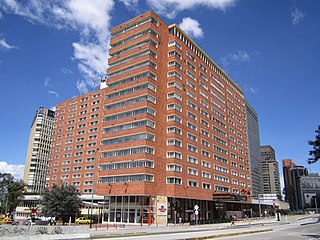
Hotel Tequendama & Centro de Convenciones is an historic hotel in Bogotá, Colombia. It is located in the San Diego neighborhood of the town of Santa Fe at the intersection of Tenth Avenue and Twenty-Sixth Avenue. The hotel, designed by Holabird & Root, John Burgee, and the Colombian architectural firm Cuéllar Serrano Gómez, was constructed between 1950 and 1951. Between 1967 and 1970, the hotel was expanded to double its original size.

